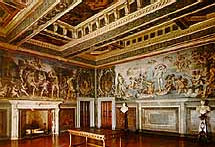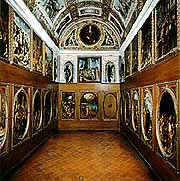
Room of the Elements
It was however from 1537, under the reign of Cosimo I, Duke of Toscany, that Arnolfo's Palace was changed completely, though without altering its austere outer aspect. In fact the Medici ruler emphasized the change in the political scene by going to live with his family in the building that had always housed the government of the city and charged his favourite architect, Giorgio Vasari, to adapt it to its new role.
Between 1540 and 1565, when the Medici family was about to move to the Pitti Palace, the Palace was more than doubled by the addition of a new block onto the rear, leaving the part that faced onto the square intact. This led to the creation of the Quarter of the Elements on the second floor, with the splendid Loggiato of Saturn and its wonderful view, and the Quarters of Eleonora di Toledo, wife of the Grand Duke, restructured and frescoed between 1559 and 1562. The passageway that links it to the Uffizi starts out from here, from the Green Room. Lastly the Quarters of Leo X (on the first floor), decorated with portraits of the most famous members of the Medici family, were remodernized by Vasari in 1555-62 on the already modified structures by Giovan Battista di Marco di Tasso, director of the work on the "Ducal Palace" (as it was then called) between 1550-55 and designer of the doorway onto Via dei Leoni.

Vasari
and school, Study of Francesco I
The two monumental staircases, the sophisticated little Study of Francesco I, a real masterpiece of Mannerist art (1570-75), and the complicated decorative programme in the Hall of the Five Hundred, that celebrate the kingdom and victories of Cosimo I, all date from Vasari's altrerations. The statue of the Genius of Victory by Michelangelo in 1506-34 stands against the wall opposite the entrance.

Michelangelo,
the Genius of Victory
The last alterations included the decoration of the Room of Maps, previously a loggia and enclosed during the first alterations: the Dominican monks Ignazio Danti and Stefano Buonsignori painted a series of 53 geographical maps of great historic interest here between 1563 and 1584.
